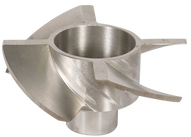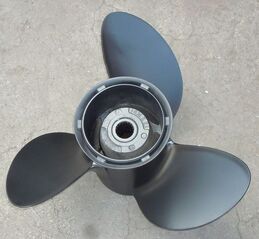|
Although they may sound alike, impellers and propellers have distinct purposes and functions. Despite being employed to propel a boat, they operate in fundamentally different ways. A propeller functions as a fan, pushing against fluid to generate forward movement by converting rotational force into linear motion. On the other hand, an impeller serves as a rotor that is typically integrated into a pump and generates a suction force, drawing fluid into a vehicle or engine. To gain a better understanding of these elements and their functions, let's delve deeper into each of them. Impeller In simple terms, an impeller is a rotor component that generates a suction force within a pump system. In the case of a boat, the impeller is composed of a series of flexible rubber vanes attached to a central hub, which rotates around an axis inside a stainless-steel liner housed within the pump. This mechanism pumps cold water into the boat's engine to cool it down while under load, and is also used to bring water from outside the boat into the plumbing system. The impeller features an inlet that allows water to flow into the boat, and the rubber vanes propel the fluid through the inlet. As the rotating component of a centrifugal pump, the impeller drives fluid away from the center of rotation, transferring energy from the pump to the water and creating velocity that propels the water outward from the pressurized pump. The impeller can be likened to an early and rudimentary version of the Archimedes screw. Impellers can be classified into three different categories based on solidity: high, medium, and low. High solidity impellers feature large, square-shaped blades that are primarily used for gas dispersion and blending of high or medium viscosity fluids. The specific design and size of these blades prevent gas from bypassing them, which could easily occur if the blades were narrower. In contrast, low solidity impellers have much thinner blades than high solidity ones and are typically employed for blending low viscosity fluids and solid suspension. Medium solidity impellers fall somewhere between high and low solidity types. Propeller A propeller can be thought of as a type of fan that generates thrust by pushing fluid away from it, converting rotational motion into linear motion (extrinsic). In the context of a boat, the propeller works by creating thrust and generating power to propel the boat forward. Propellers typically have three or four blades that rotate around an axis, driving the boat through the water. As the blades rotate, the water pressure behind each blade increases, propelling the boat forward. The angle at which the blades protrude from the hub allows water to flow from the front of the propeller to the rear without pushing water to the sides. Generally, increasing the number of blades on a propeller can enhance the power generated by the vehicle and reduce drag. The thrust generated by propellers can be explained by either Bernoulli's theorem or Newton's laws of motion.
0 Comments
Leave a Reply. |
Details
Jet Ski & Boat Magazine - Your Ultimate Guide to Water AdventuresWelcome to Jet Ski & Boat Magazine E Zine, your go-to source for all things related to water sports and personal watercraft. Our E zine magazine is dedicated to providing you with the latest news, tips, and stories from the world of jet skiing, boating, and other exciting water activities. Categories
All
Archives
|
LOW PRICE Guarantee! We will meet or beat any advertised price!
|
|
We have the impeller edge on lowest prices, highest quality and performance impellers world wide
Personal Watercraft Jetski ATV Motorcycle Snowmobile SXS & Sport boat JetBoat Performance Since 1994
sportboatparts.com JetSkiParts.biz SportJetBoat.com
sportboatparts.com JetSkiParts.biz SportJetBoat.com
2024 Copyright Impellers.com
 RSS Feed
RSS Feed


